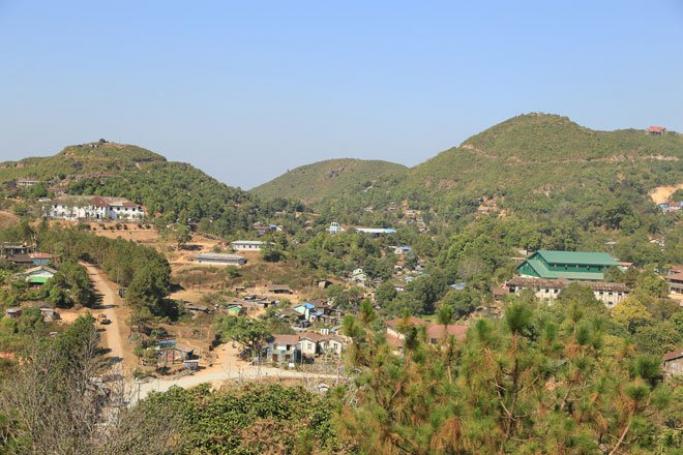Near the top of the Dawparkho mountain range in Kayin State, at the end of a road that runs east from Taungoo is Thandaung Gyi, one of the less well known of the hill stations established during British colonial rule.
Retreating to hill stations to escape the searing summer heat of the plains was a tradition established by the British in India and replicated in Myanmar, most notably at Pyin Oo Lwin, formerly Maymyo.
Thandaung Gyi, a quaint, picturesque town in which most of the population are Karen Christians, is in an area of Kayin State that had long been off-limits to foreigners because of civil conflict.
The return of peace to the area has seen travel restrictions eased and Thandaung Gyi is attracting small numbers of visitors keen to explore destinations off the beaten track.
You’ll find no tourist centres or hawkers selling tacky trinkets in the town, that can be reached by a two-hour motorbike journey from Taungoo, in neighbouring Bago Region. The road climbs into the lush countryside of this region of northern Kayin State. Just outside the town is a police checkpoint where the officer on duty was utterly baffled by the sudden appearance of myself and a foreign travelling companion. We were a bit apprehensive ourselves because we were not sure if we would be allowed to proceed. But after a brief exchange with the smiling police officer, an assurance we would not be staying overnight and the handing over of copies of our passports, we were waved through.
The presence of Naw Bu Baw Mountain and its legend hovers over the town. According to the legend, Naw Bu Baw was the beautiful daughter of the king of the sea who married a local prince, Saw Thaw oh Khwa. Her foreign status, coupled with the fact that she possessed a magical comb that could make her invisible, led to her being distrusted by the local people. When her husband went to war and the magical comb she gave him was unable to save his life, Naw Bu Baw was dragged to the mountain’s summit and put on trial for witchcraft. She was found guilty and lived out her life in a dusty rock cavern that locals will be happy to show you.
This grim legend is easily forgotten as you stand on the peak and admire the panoramic view of the surrounding jungle-clad mountains.
Most of the buildings in the small area that comprises “downtown” Thandaung Gyi were built of teak and some have been well maintained. One of the most impressive buildings dominates a small hill at the end of a dusty track. It’s a large structure behind a bamboo fence and the Myanmar flag flutters at the front of the property in an area where the blue, white and red flag of Kayin State hangs above almost every door.
A cross adorns the top of a prayer room on the path to the summit of Mount Naw Bu Baw. Photo: Aurelia Rusek
We couldn’t resist a closer look but were threatened by three growling dogs. An elderly man limped out of the front door with his wife and shouted a command at the dogs that transformed them into and until an elderly man limped out of the front door, shouted at the dogs Three dogs growled as we approached on the motorbike, scaring me enough to almost topple into a ditch, but then an elder man limped out of the front door with his wife, shouted a command at the dogs and they withdrew.
The building was established during the colonial period as a tea factory that after independence had supplied the Tatmadaw. The elderly man, a former captain in the Tatmadaw, was the manager of the factory that employs a few dozen of the town’s residents. Given the history of tension between many Karen people and the Tatmadaw, I asked about his relationship with the local people given his military background.
“No problem at all, my wife is Karen,” he said.
During British rule, the building had processed and exported tea to Europe. Tea plantations, as well as those producing coffee and the leaves used to wrap cheroots, still thrive in the hills around the town. On another hill above the town, there’s a decaying teak structure nestled among the jungle that could have been the summer home of a wealthy tea merchant.
We could find only one functioning restaurant in Thandaung Gyi. It is in a small bamboo hut and is run by an elderly woman of Nepalese descent and her family. The woman said the small Nepalese community in the town was the legacy of labour brought in by the British to work at the tea factory.
Because of its small size, there are few activities in Thandaung Gyi to keep visitors entertained apart from strolling its charming streets. The attractions include old churches, some charming teak houses and well-manicured gardens. The pedestrian traffic in the streets includes families of waddling ducks.
Thandaung Gyi is easy to reach from Taungoo, 27 miles (43 kilometres) away. The road is steep but in good condition all the way and cars and motorbikes can make the journey in about two hours. It must be one of the most scenic journeys in Myanmar. If you opt to hire a motorbike from Taungoo it will cost K10,000 a day.
There is debate about whether it is possible to spend the night in Thandaung Gyi and those hoping to do so should check in advance with the relevant authorities to avoid disappointment.
Accommodation is available at the Zion Hill Church guesthouse but it is basic, with no beds and a few blankets. The view at dawn from its hilltop site would more than compensate for an uncomfortable night’s sleep.
This Article first appeared in the March 12, 2015 edition of Mizzima Weekly.
Mizzima Weekly is available in print in Yangon through Innwa Bookstore and through online subscription at www.mzineplus.com












